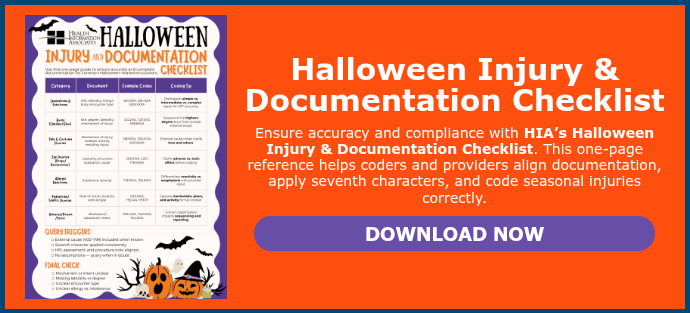
Halloween brings fun, fright—and a rise in emergency and urgent care visits. From pumpkin-carving cuts to hot glue burns, seasonal injuries can present coding challenges when documentation lacks detail. This guide outlines common Halloween-related encounters and provides ICD-10-CM coding examples, documentation tips, and query reminders to help ensure every case is coded accurately and compliantly.
Pumpkins, costumes, and candy make Halloween fun—but also prime time for injuries. Every October, there is a spike in emergency and urgent care encounters for lacerations, burns, falls, and allergic reactions. Coders and auditors need to be ready to accurately assign ICD-10-CM codes, including applying correct seventh characters, and capturing external cause details when available. This mini-guide highlights the most common Halloween-related injuries and how to ensure documentation supports accurate code assignment.
Lacerations and Puncture Wounds
Common Scenarios: Pumpkin carving accidents, broken glass injuries, knife slips.
Documentation Should Include:
- Specific site and laterality
- Depth and presence of contamination or foreign body
- Encounter type (initial, subsequent, or sequela)
- External cause of injury details
Examples:
- Cut right index finger with knife while carving pumpkin → S61.210A (Laceration without foreign body of right index finger without damage to nail, initial encounter) + W26.0XXA (Contact with knife)
- Puncture wound of left hand from broken glass decoration → S61.432A (Puncture wound without foreign body of left hand, initial encounter) + W25.XXXA (Contact with sharp glass)
🎃 Coding Tip: If repair was performed, verify documentation supports simple, intermediate, or complex repair for accurate CPT reporting and future audit defense.
Burns from Candles and Hot Glue Guns
Common Scenarios: Contact with open flame, hot glue, or wax.
Documentation Should Include:
- Site, degree, laterality, and extent (TBSA if applicable)
- Mechanism (flame, chemical, electrical)
Examples:
- Second degree burn to right forearm from candle flame → T22.211A (Burn of second degree of right forearm, initial encounter) + X08.8XXA (Exposure to other specified smoke, fire, and flames)
- First degree burn to right finger from hot glue → T23.121A (Burn of first degree of single right finger (nail) except thumb, initial encounter) + X19.XXXA (Contact with other heat and hot substances, initial encounter)
🎃 Coding Tip: When multiple burns occur, sequence the highest-degree burn first, and don’t forget the external cause code describing how it happened.
Falls and Costume Mishaps
Common Scenarios: Trips on costumes, falls on/from steps or porches.
Documentation Should Include:
- Mechanism of fall (trip, slip, fall)
- Place of occurrence
- Activity at the time of the event
Examples:
- Abrasion of left lower leg from fall in driveway of patient’s single-family house after tripping on hem of costume → S80.812A (Abrasion of left lower leg, initial encounter) + W01.0XXA (Fall on same level from slipping, tripping and stumbling without subsequent striking against object) + Y92.014 (Private driveway to single-family house as the place of occurrence of the external cause)
- Fracture of right calcaneus from slipping on wet porch of an apartment when handing out Halloween candy → S92.001A (Unspecified fracture of right calcaneus, initial encounter) + W18.49XA (Other slipping, tripping and stumbling without falling) + Y92.038 (Other place in apartment as the place of occurrence of the external cause)
🎃 Coding Tip: External cause codes (V00–Y99) aren’t always required for billing, but they’re valuable for injury surveillance and quality reporting—and they tell the story behind the injury.
Eye Injuries from Props or Accessories
Common Scenarios: Corneal abrasions, allergic reactions
Documentation Should Include:
- Laterality and anatomic site
- Substance or product involved
Examples:
- Corneal abrasion of right eye from cosmetic contact lenses → S05.01XA (Injury of conjunctiva and corneal abrasion without foreign body, right eye, initial encounter) + Y77.2 (Prosthetic and other implants, materials and accessory ophthalmic devices associated with adverse incidents)
- Allergic contact dermatitis of the eyelid due to adhesive from false eyelashes → L23.1 (Allergic contact dermatitis due to adhesives)
🎃 Coding Tip: Injuries require assignment of a 7th character based on the nature of the encounter.
Adverse Effects vs. Poisoning vs. Toxic Effects
Common Scenarios: Food allergies, exposure to chemicals
Documentation Should Include:
- Offending substance (food, drug, chemical)
- Severity of reaction
- Intent
Examples:
- Anaphylactic shock secondary to peanuts in Halloween candy → T78.01XA (Anaphylactic reaction due to peanuts, initial encounter)
- Nausea, vomiting, dizziness secondary to accidental toxic effect of spray paint used to decorate a Halloween costume→ T65.6X1A (Toxic effect of paints and dyes, not elsewhere classified, accidental (unintentional)
🎃 Coding Tip: Be cautious when the record lacks clarity on severity—query when uncertain between mild reaction, urticaria, or true anaphylaxis.
Pedestrian and Traffic-Related Injuries
Common Scenarios: Trick-or-treaters hit by vehicles, bicycle falls, scooter accidents.
Documentation Should Include:
- Patient’s role (pedestrian, passenger, driver)
- Vehicle type and location of accident
Examples:
- Child in struck by car when crossing the road while walking through his neighborhood trick-or-treating → V03.10XA (Pedestrian on foot injured in collision with car, pick-up truck or van in traffic accident) + Y92.414 (Local residential or business street as the place of occurrence of the external cause) + Y93.01 (Activity, walking, marching and hiking)
- Teen fell from bicycle without collision while riding on sidewalk → V18.0XXA (Pedal cycle driver injured in noncollision transport accident in nontraffic accident) + Y92.480 (Sidewalk as the place of occurrence of the external cause) + Y93.55 (Activity, bike riding)
🎃 Coding Tip: Combine injury codes with external cause, place of occurrence, and activity codes to give a full picture of the event.
Adverse Effect vs. Poisoning vs. Toxic Effect
| Situation | Example | Category & Code |
| Correct drug, correct dose, side effect | Nausea after prescribed codeine | T40.2X5A – Adverse effect of other opioids |
| Wrong substance or dose of drugs | Child ingests parent’s medication | T40.2X1A – Poisoning by other opioids, accidental |
| Harmful, non-medicinal substance | Chemical burn from makeup remover | T54.3X1A – Toxic effect of corrosive alkalis and alkali-like substances, accidental |
🎃 Coding Tip: If a reaction is caused by a prescribed medication taken correctly, it’s an adverse effect—not poisoning. Misuse or wrong dose of drugs changes the code.
Common Query Prompts
- “Can you specify how the injury occurred?”
- “What was the degree of the burn?”
- “Was the right or left side affected?”
- “Was this an allergic reaction?”
🎃 Coding Tip: Always verify that the seventh character (A, D, or S) identifying type of encounter is applied consistently across all related codes.
Final Takeaway
Halloween injuries may be temporary, but documentation quality has long-term effects on coding accuracy, audit readiness, and quality data. Encourage providers to describe who, where, how, and what happened in every injury note—and coders to leverage external cause codes when applicable.
Frequently Asked Questions
What are the most common Halloween injuries coders encounter in ED and urgent care settings?
Why are external cause codes important for Halloween injury coding?
How can providers improve documentation for seasonal injuries like burns or falls?
Providers can prevent queries and denials by documenting key details such as mechanism of injury, severity (degree or depth), location, laterality, and activity at the time of injury. Including these elements helps coders correctly apply seventh characters, external cause codes, and sequencing rules for ED and urgent care encounters.
For more than 30 years, HIA has been the leading provider of compliance audits, coding support services and clinical documentation audit services for hospitals, ambulatory surgery centers, physician groups and other healthcare entities. HIA offers PRN support as well as total outsource support.
The information contained in this coding advice is valid at the time of posting. Viewers are encouraged to research subsequent official guidance in the areas associated with the topic as they can change rapidly.
Subscribe to our Newsletter
Recent Blogs
Related blogs from Industry News , Medical Coding Tips , Holidays
Interventions for endovascular revascularizat...
The 2026 updates to CPT and the Hospital Outp...
Accurate diagnosis coding relies on recognizi...
This is a series of blogs about the importanc...
Subscribe
to our Newsletter
Weekly medical coding tips and coding education delivered directly to your inbox.


.png)


